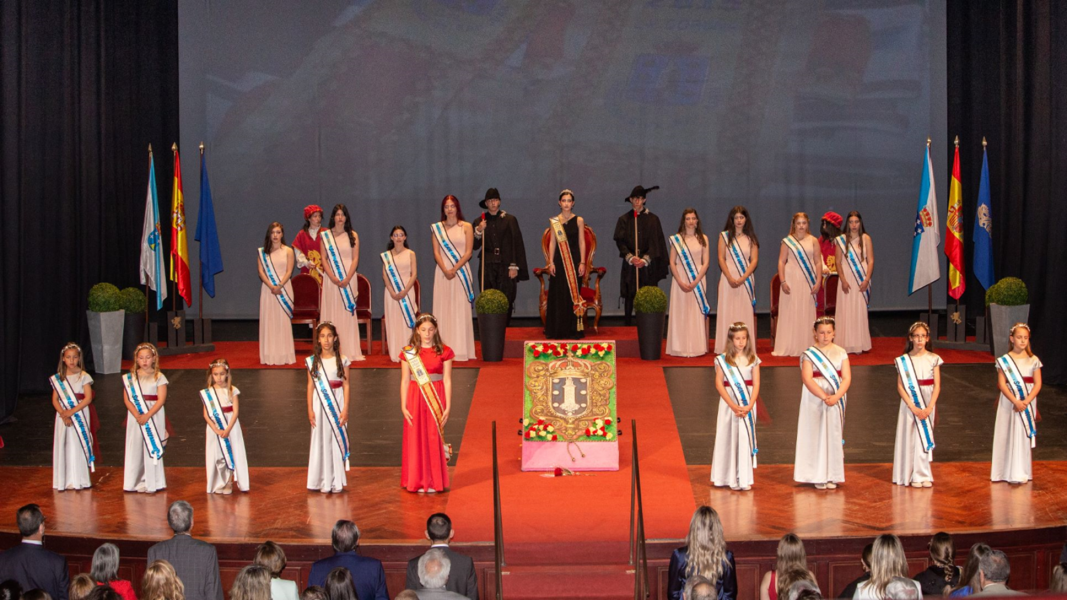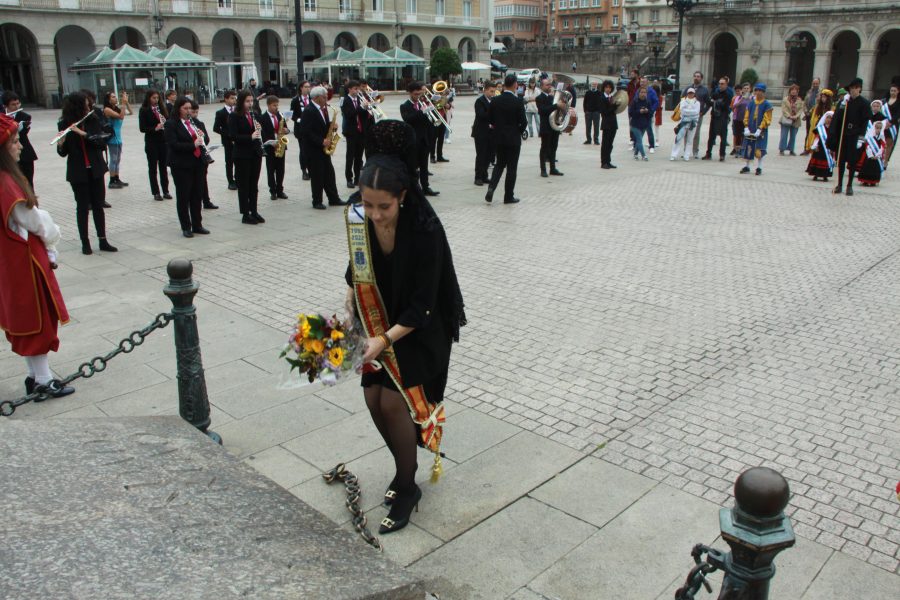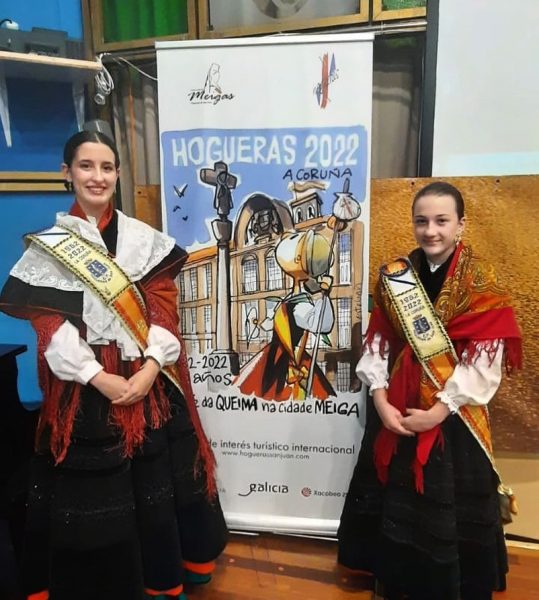The etiquette of Las Meigas
From the first years of the Promotion Commission, one of the main concerns was to adapt the label of the Meigas to the festive reality that it was intended to promote; It was therefore, from the beginning, to set guidelines so that the Meigas, in their public participations, were easily identifiable and distinguished as such.
After the first experience in 1970 in which the Meiga Mayor wore a funny witch costume and her Meigas de Honor wore the Galician Regional Costume, from the following year it was determined that the Meiga Mayor would keep the color black in her Proclamation Costume in so much so that the Meigas de Honor were invited to wear an evening dress without a specific design or color.
It was from 1972 when the Meigas de Honor began to dress in a white evening dress, keeping the Meiga Mayor the color black as the most characteristic sign of their etiquette.
This custom of using the Meigas de Honor white evening gowns made the same for all lasted for many years until finally, in accordance with fashion patterns, it was decided that these gowns could be made from fabrics of other colors while maintaining their both chromatic and workmanship uniformity.
For their part, the Meigas infantiles, during the first two years of their existence, also dressed in charming witch costumes, this custom disappearing definitively in 1974, when they began to wear the Galician Regional Costume.
At first, both the older Meigas and the children wore this special clothing only to attend, the older ones, the Poetic Coven Festival and the Noite da Queima, while the children used it in their act of Proclamation and in the Coven Party they attended as guests.
In 1983, the decision was made that the Meigas go to the Offering to Saint John wearing the regional Costume of Galicia, being replaced, the following year, by the traditional Spanish Mantilla that, since then, has been associated with religious acts. attended by the Meiga Mayor and the Meigas de Honor every year.
Over the years, as the participation of the Meigas in the different acts of the HOGUERAS program increased, regulations were dictated to set the label on the occasion of their participation in these acts. All this has been fixed in the so-called “Regulation of acts, precedence, granting of distinctions and identification signs” of the Promotion Commission, in force today, with very few variations, as it is assumed by the Meigas Association.
This Regulation describes the following as the label of the Meigas:
1º. Official Gala Suit:

Miss Meiga Mayor: Long black dress, according to the official design, with black shoes and stockings and wearing her accrediting band and headband, where appropriate.
Miss Meiga Mayor Infantil: Ankle-length or long dress, maroon in color and made according to the official design, with matching shoes and stockings and wearing her accrediting Band.
ladies Meigas de Honor: Long dress of the same color for all, according to the official design, with matching shoes and socks and wearing their accreditation Band.
2º. Mantilla suit:

Miss Meiga Mayor: Black suit, with black mantilla and comb; black court shoes with black stockings. Wearing his accrediting Band and the distinctive Meiga Mayor Medal.
ladies Meigas de Honor: Black suit, with black mantilla and comb; black court shoes with black stockings. Wearing their accrediting Bands and the distinctive Meiga de Honor Medals.
3º. Galician Traditional Costume.

Miss Meiga Mayor: Characteristic costume of the Mariñas region or another region of Galicia, with black shoes typical of the Regional Costume and stockings typical of the Costume, with her hair tied up in a braid topped with a black silk bow. Wearing his accrediting Band. For the religious acts that are determined, it will be dressed with a cap, white mantilla or bobiné.
Miss Meiga Mayor Infantil: Characteristic costume of the Mariñas region or another region of Galicia, with black shoes typical of the Regional Costume and stockings typical of the Costume, with hair tied back in a braid topped with a black silk bow. Wearing his accrediting Band. For religious acts, it will be adorned with a white cap or mantilla.
ladies Meigas de Honor: Characteristic costume from the Mariñas region, or from another region of Galicia, with black shoes typical of the Regional Costume and stockings typical of the Costume, with their hair tied back in a braid topped with a black silk bow. Wearing their accrediting Bands. For the religious acts that are determined, it will be dressed with a cap, white mantilla or bobiné.
ladies Children’s Meigas de Honor: Characteristic costume of the region of Las Mariñas or another region of Galicia, with black shoes typical of the Regional Costume and stockings typical of the Costume, with their hair gathered in a braid topped with a black silk bow Wearing their accrediting Bands . For religious acts they will be adorned with a white cap or mantilla.
4º. Others:
There is also the so-called sports uniform, released in 2001, which varies depending on the case, although it is usually made up of a polo shirt with the Commission’s logo and a beige skirt or jeans.
As for when and under what specific circumstances each of these outfits is worn, the rules are set by the Coordination Department of the Commission, which establishes the following:
A.- Institutional Acts:
Miss Meiga Mayor, Miss Meiga Mayor Infantil, Ms. Meigas of Honor and Misses. Children’s Honor Meigas, where appropriate, with Galician Traditional Costume, wearing the accrediting Band.
The Proclamation Ceremony and imposition of Bands are considered institutional acts; the Day of Tribute to Coruñesa Women; the Tribute to the Flag; the receptions offered by Authorities or Social Entities; visits to Nursing Homes and charity centers; attendance at events organized by other Institutions or Entities if no other label expressly appears; as well as the participation in the different acts of the HOGUERAS program for which no other label is foreseen.
B.- Religious acts:
Miss Meiga Mayor and Misses. Meigas de Honor, where appropriate, with a Spanish Mantilla, wearing the accrediting Band and the corresponding distinctive Medal. In certain cases, Ms. Meiga Mayor and Ms. Meigas de Honor, will be able to wear the Galician Traditional Costume to attend these acts, adorned with a cap, white or bobiné mantilla and the accrediting Band.
Miss Meiga Mayor Infant and Misses. Children’s Meigas de Honor, where appropriate, with traditional Galician dress adorned with a white cap or mantilla and the accrediting band.
religious acts are considered the Act in remembrance (June 1); the Commemorative Holy Mass (June 1); the acts of the morning of the Eve of San Juan (June 23); the acts of the Day of San Juan (June 24); the Acts of August 29; participation in Holy Week processions and others of a religious nature organized by Institutions or Entities.
C.- Gala parties:
Miss Meiga Mayor, Miss Meiga Mayor Infantil, Ms. Meigas of Honor and Misses. Children’s Meigas de Honor, where appropriate, with the Official Gala Suit.
Within the HOGUERAS program, the Meigas attend the Poetic Coven Party wearing the Official Gala Dress; Poetic Solstice Festival; Meigas Dance Festival; Cavalcade of San Juan and Noite da Queima.
They will also wear this clothing in those other acts that, organized by Institutions or Entities, require a label or in those whose use is determined by the Promotion Commission.
D.- Others:
They will be issued for each specific case. Within the HOGUERAS program, the so-called sports uniform is used on the occasion of the celebration of the San Juan Week Children’s Party.
Eugenio Fernández Barallobre.


